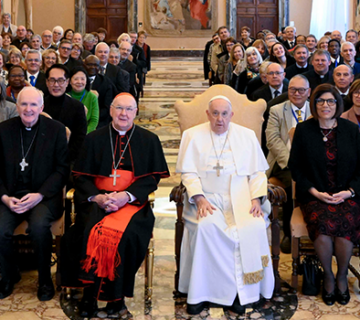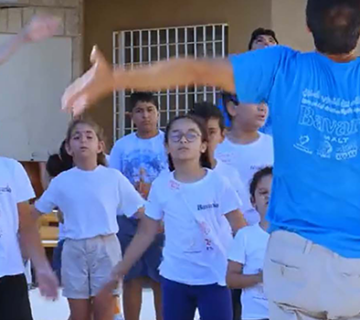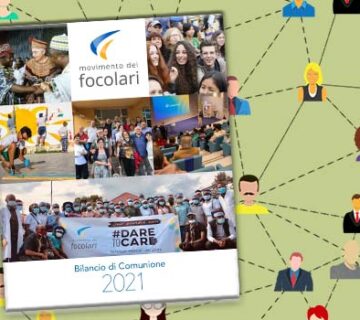 Fatima, 19 August. It was the high moment of Maria Voce and Giancarlo Faletti’s visit to Portugal: the meeting with all the members of the Focolare from every corner of Portugal, including the most distant islands. It was a long-awaited meeting, since it had been postponed for eight months. A true feast in an atmosphere of “rejoicing” that has been the mark of every day of this visit.
Fatima, 19 August. It was the high moment of Maria Voce and Giancarlo Faletti’s visit to Portugal: the meeting with all the members of the Focolare from every corner of Portugal, including the most distant islands. It was a long-awaited meeting, since it had been postponed for eight months. A true feast in an atmosphere of “rejoicing” that has been the mark of every day of this visit.
“I’ve come to Fatima to entrust the Focolare Movement to Our Lady together with all of you,” the president told everyone. Few people realize that the Focolare Movement was officially approved by the Catholic Church with the name “Work of Mary” because of its nature which is very lay and “Marian”. And so our link to the Mother of Jesus is quite strong, strong as that of the Portuguese. It is this link that forms the very identity of the Portuguese people and reaches beyond religious or secular beliefs. It impregnates the music, the culture, the art, the architecture of their world and their way of expressing themselves. They are people who do things seriously, with sobriety and discretion and harmony. The ancestral relationship of the Portuguese with “Nnossa Senhora” (Our Lady) is quite striking. As far back as 1646, King Dom Joao IV offered his crown to the Immaculate Virgin, entrusting his people to Her and proclaiming Her “Rainha de Portugal” (Queen of Portugal). Ever since then no king has ever wanted to wear the crown that still belongs to no one but Her.”
In the morning after a lively dialogue with 140 Gen3 who together with the adults are committed to living for a more united world, Maria Voce and Giancarlo Faletti were welcomed to Paul VI Hall by 1,800 members of the Movement who are the main animators of the more than 25,000 people who belong to the Focolare family in this land.
In a growing atmosphere of joy, the various Focolare communities were presented from around the country, and they shared testimonies and projects in this moment of economic crisis, that assist those who are in need. It was a real lesson on living the Gospel. Maria Voce exclaimed: “I seem to see many lights, many burning fires that are spread all over, fires that illumine and warm those who draw near to them.” This was followed by a very solemn moment as the faces of members of the Movement filed across the screen, adults, priests, children and religious who have concluded their earthly journey but continue to give witness with their lives that the life of the Spirituality of Unity is a new way of holiness.
Then there was an open discussion. Miguel (9 years old), asked Maria Voce what she thought when she was elected to be president of the Movement. “It seemed to me,” she replied, “that Jesus was asking me: ‘Do you love me? Do you want to help in bringing Chiara’s work forward? If you love me, I’ll help you!’ Now, what would you have said if you were in my place? You would certainly have said: ‘Let’s do it together then!’” Next the Gen4 handed over to her the money they had saved for the poor and needy children of the world.
This was followed by questions from youths and adults: on how to become involved in the local parish community; how to reconcile work commitments with the Movement and the family. There was a very strong desire in everyone to imitate Mary, to live a more sober life, and to discern a vocation. They also spoke about inculturation and the role of Portugal in the context of Europe and, in particular, the specific contribution of the Movement in this regard. The size of the crowd with so many youths moved Maria Voce to say: “Portugal can certainly say that they have youths! And then here you feel such a strong and particular presence of Mary that you (Portuguese) are able to witness better than anyone else.”
In the afternoon a “Musical” was performed by both young and old. The plot opened with a glimpse into Portuguese history and the arrival of the Focolare Movement in the 1960’s. The main elements of the Portuguese culture were presented: the sacredness of fado music, the famous singing groups from Alentejo in south-central Portugal; the colourful popular dances from different regions and from the islands; modern dance and the songs from the youths. The engaging history was accompanied by images on a giant screen.
The busy day flew by in a flash. Everyone left Fatima with a desire to bring this “rejoicing” everywhere, this fire of Gospel love that was burning in the hearts of all.
By Gustavo Clariá


 Italiano
Italiano Español
Español Français
Français Português
Português



No comment